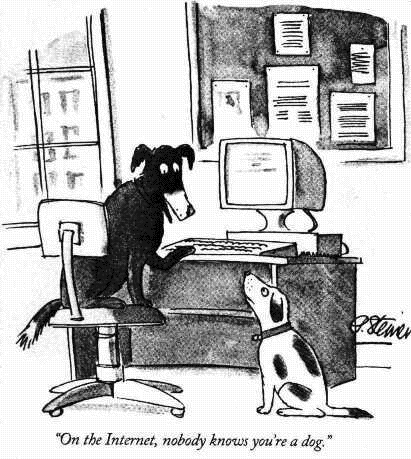

The Webster's Dictionary defines identity as “the distinguishing character or personality of an individual.” Computer mediated communication seems to change this definition to one of the distinguishing characters or personalities of an individual. People can have more than one identity. There are many ways that a person's identity can be manipulated on-line. A man can become a woman or visa versa. Physical characteristics can be altered. Ethnicity can be altered. Age can be altered. Essentially a person can become the exact opposite of his/her material self. There are many questions that arise with this issue. Is it moral to pretend to be someone you are not? Is it legal to pretend to be someone else?
These questions have many answers. Some of the answers bring about more questions. Are you using a different identity to be deceitful? Is this change in identity made to help expand your personality? Why do people want to change their identity online?
Let’s start with the last question. I can see many reasons that someone would want to change their identity. Maybe they are overweight or not very attractive. Maybe they are short and wish they were tall. It seems odd that these characteristics would matter with CMC because no one can see you, but they do seem to make a difference. These are simple changes that someone can make online. These changes are somewhat deceitful, however, they may help a person begin to accept their material being more. How? Well by being a different person online line a person may get attention that they normally would not get in face to face communication. This attention (I believe everyone wants the attention of others) might in turn help the self-esteem of the person. Growth in self-esteem might eventually help a person’s self-respect.
Some people may want to change their identity just to “toy” with the system. There are many people that like to “rock the boat.” They get a kick out of stirring up others who need structure and order.
Others may have certain identity traits that they wish to express but are very shy and inhibited during face to face conversation. For these individuals the use of CMC can be similar to using alcohol. It can lower inhibitions. CMC is different than F2F conversation because the individual does not have to deal with the psychological aspects that come into play when some is focused on you, looking at you, and making the regular facial expressions. When you are intoxicated these issues go away due to the depressed sensations and perceptions. With CMC you don't have to see the person you are communicating with.
“Users of IRC treat the medium as a frontier world, a virtual reality of virtual freedom, in which participants feel free to act out their fantasies, to challenge social norms, and exercise aspects of their personality that would under normal interactive circumstances be inhibited. The medium itself blocks some of the socially inhibiting institutions that users would, under other circumstances, be operating within.” (Reid, 1991) People that alter their identity for this reason may overtime be able to express them selves better in F2F communication. The CMC is a time to practice their social communication.
The idea of what community is varies from from person to person. M. Scott Peck has this to say, "The key to community is the acceptance - in fact, the celebration - of our individual and cultural differences. Such acceptance and celebration - which resolves the problem of pluralism and which can occur only after we learn how to become empty - is also the key to world peace."(Peck,1988).
He defines it as "...a group of two or more people who, regardless of the diversity of their backgrounds, have been able to accept and transcend their differences, enabling them to communicate openly and effectively, and to work together towards common goals, while having a sense of unusual safety with one another."(Peck,1988). The Webster's Dictionary has many definitions here are the first two:
I think that most people automatically think of the second definition when think hear the word community. I tend to think of the first definition and Peck's definition when I hear the word. Ok to the point. There is an argument about whether community can take place through CMC or if we need to have F2F contact in order to develop it. I believe that if you are referring to community in the sense of definition #2 the answer is that face to face communication is necessary. However, if you are referring to definition #1 or Peck's definition, I think the answer is, community can be built through CMC. If we were to follow Peck's ideas about community this would be the ideal place for community to happen. He says that community could eventually lead to world peace. The internet and CMC open up a means to make this happen. It would be practically impossible for this to be a complete process with F2F communication. After all the world is a big place. The presence of the internet makes the world a much smaller place. It would would be easier I think to get past our cultural differences with CMC.
People are usually racist because they fear or misunderstand the differences between their culture and someone else's. The internet provides a culture within itself. This culture could become the common culture of the world and give people similarities with each other that make them more comfortable. “Users of IRC share a vocabulary and a system of understanding that is unique and therefore defines them as constituting a distinct culture.”(Reid, 1991)